Zebra Technologies VC6090 Vehicle Computer User Manual VC6000 Series Quick Reference Guide
Zebra Technologies Corporation Vehicle Computer VC6000 Series Quick Reference Guide
User manual
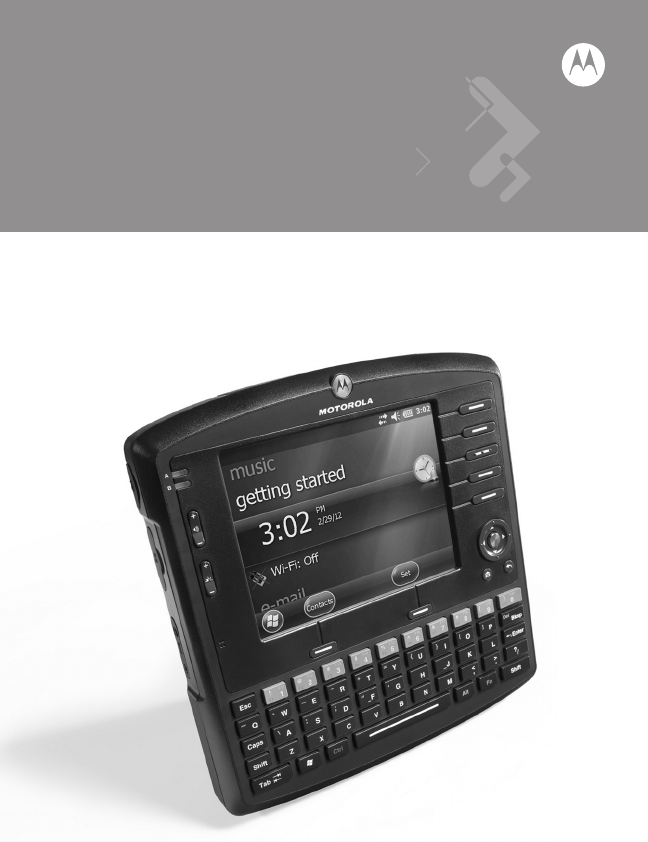
VC6000 Series
Quick Reference Guide
© 2012 by Motorola Solutions, Inc. All rights reserved.
No part of this publication may be reproduced or used in any form, or by any
electrical or mechanical means, without permission in writing from Motorola. This
includes electronic or mechanical means, such as photocopying, recording, or
information storage and retrieval systems. The material in this manual is subject
to change without notice.
The software is provided strictly on an “as is” basis. All software, including
firmware, furnished to the user is on a licensed basis. Motorola grants to the user
a non-transferable and non-exclusive license to use each software or firmware
program delivered hereunder (licensed program). Except as noted below, such
license may not be assigned, sublicensed, or otherwise transferred by the user
without prior written consent of Motorola. No right to copy a licensed program in
whole or in part is granted, except as permitted under copyright law. The user
shall not modify, merge, or incorporate any form or portion of a licensed program
with other program material, create a derivative work from a licensed program, or
use a licensed program in a network without written permission from Motorola.
The user agrees to maintain Motorola’s copyright notice on the licensed programs
delivered hereunder, and to include the same on any authorized copies it makes,
in whole or in part. The user agrees not to decompile, disassemble, decode, or
reverse engineer any licensed program delivered to the user or any portion
thereof.
Motorola reserves the right to make changes to any software or product to
improve reliability, function, or design.
Motorola does not assume any product liability arising out of, or in connection
with, the application or use of any product, circuit, or application described herein.
No license is granted, either expressly or by implication, estoppel, or otherwise
under any Motorola, Inc., intellectual property rights. An implied license only exists
for equipment, circuits, and subsystems contained in Motorola products.
Motorola Solutions, Inc. 1301 E. Algonquin Rd.
Schaumburg, IL 60196-1078, U.S.A
www.motorolasolutions.com
Warranty
Subject to the terms of Motorola’s hardware warranty statement, the VC6000
series products are warranted against defects in workmanship and materials for a
period of one year from the date of shipment.
For the complete Motorola hardware product warranty statement, go to:
www.motorola.com/enterprisemobility/warranty.

Quick Reference Guide 1
Introduction
The Motorola VC6000 series is a rugged vehicle computer, specifically
designed for the harsh conditions of the mobile environment.
The VC6000 series enables real-time data access, collection, capture
and report of information related to the driver’s workflow, status and
location.
The VC6000 series offers low width and height and thin design for
minimal driver obstruction and maximum space utilization. It has a
rugged construction: IP64-sealed, aluminum rear housing and
MIL-STD-810F military ratings. The unit is designed to withstand the
most extreme environments including lift truck mounting use cases.
The VC6000 series offers programmable navigation keys with tactile
feedback and QWERTY keyboard with large keys ideal for gloved hands,
all backlit.
Data can be entered using the touch-screen, built-in keyboard or an
external bar code scanner.
Cellular and Wi-Fi radios are used to exchange voice and data with wide
and local area networks.
Bluetooth
TM
technology is used for cordless connection of peripheral
devices such as printers, bar code scanners, handsfree speakers and
headsets.
Among its many communication interfaces, the VC6096 model contains
an internal Global Positioning System (GPS) receiver, ensuring reliable
and accurate vehicle location.
The VC6000 series offers light weight flexible mounting with VESA100
compatibility.
The VC6090 comes with pre-loaded, Pre-licensed Terminal Emulation
for out-of-the-box terminal emulation solution.
The VC6090 is MSP compatible with easy and cost-effective centralized
remote management.
The VC6000 series provides USB connectivity with two USB host ports
to connect a corded bar code scanner and for a service flash memory
stick. Another USB Client port is provided for ActivSync.

2 VC6000 Series Vehicle Computers
It also provides RS232 and GPIOs connectivity with two RS232, 8 Digital
Inputs, 8 Digital Outputs and 2 Analog Inputs for building flexible
solutions.
While the VC6090 model includes internal antennas, the VC6096 model
external antennas and other accessories require a professional
installation, performed by trained and licensed personnel. For proper
installation requirements, contact your professional installer, VAR, or
antenna manufacturer.

Quick Reference Guide 3
About this Guide
This guide contains the following:
•Model Configurations on page 4
•Features on page 6
•Unpacking on page 8
•Optional Accessories for VC6090 on page 9
•Optional Accessories for VC6090 on page 9
•Installing a SIM Card (VC6096 only) on page 10
•Installing the SD Memory Card on page 11
•Mounting on page 12
•Operating the VC6000 series on page 25
•Troubleshooting on page 28
•Regulatory Information on page 28
For more information, refer to the VC6000 series Product Reference
Guide, p/n 6802986C08-x available at:
www.motorola.com/enterprisemobility/manuals.
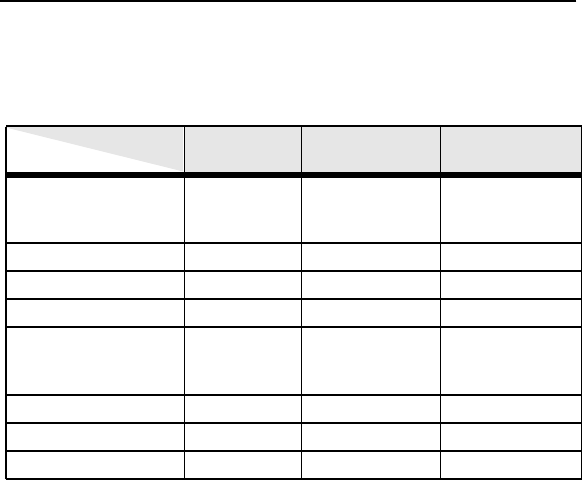
4 VC6000 Series Vehicle Computers
Model Configurations
This guide covers the configuration of the following VC6000 series
models:
The VC6000 series features:
• Ergonomic design with a color LCD touch screen
• Windows Mobile 6.5 operating system
• Internal Bluetooth radio to enable wireless connection to a Bluetooth
printer, bar code scanner, headset and other Bluetooth peripherals
• Connection to WLAN in 802.11a/b/g standards (VC6090 and VC6096)
• Connection to WWAN using a Global Positioning System (GSM) for
mobile communication, cellular radio and High-Speed Downlink
Packet Access (HSDPA) (VC6096 only)
• 10/100 Ethernet port for connection to Local Area Network (LAN)
• Vehicle motion and location detection via the vehicle telemetry and the
GPS receiver (VC6096 only)
• Serial RS232 interface and GPIOs
• Two full speed USB ports (One with 1A power output, VC6090 only)
Configuration Model VC6000 VC6096 VC6090
Operating System Windows
Mobile 6.5
Classic
Windows Mobile
6.5 Professional
Windows Mobile
6.5 Classic
GPS No Yes No
Bluetooth (BT) Yes Yes Yes
Wireless LAN No Yes (802.11 a/b/g) Yes (802.11 a/b/g)
Cellular radio
(HSDPA, UMTS, GSM,
GPRS, EDGE)
No Yes (Voice and
data)
No
Vehicle Telemetry No Yes No
Internal BT Antenna Yes Yes Yes
Internal WLAN Antenna No No Yes

Quick Reference Guide 5
• Flexible power options:
- Direct 10V to 33Vdc, with ignition sense for gas/diesel-powered lift
trucks and vehicles with 12V or 24V battery.
- External 18 to 75V DC-to-DC converter for electric-powered lift truck
with 24V, 36V or 48V battery (VC6090 only).
- External 100 to 240VAC power supply for AC-powered carts and sta-
tionary installation.
• Reliable operation in cold environments, as low as -20 °C (- 4 °F)
• Maximum operational temperature 60 °C (140 °F)
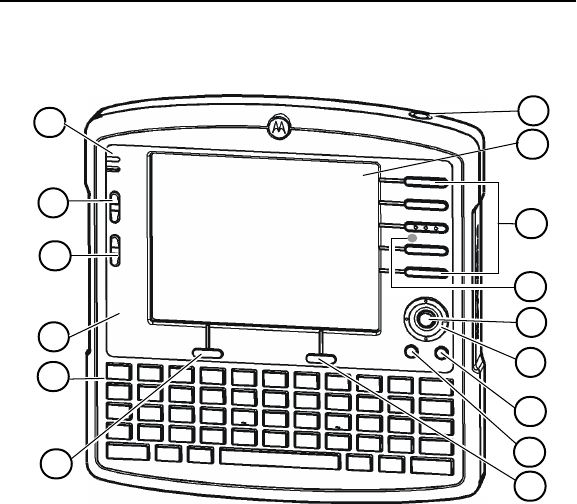
6 VC6000 Series Vehicle Computers
Features
Front Features
1 See “System Indication LED” on page 25.
2 For LED indications, refer to your enterprise application guide.
3 VC6090 numeric keys also marked as F1-F20 function keys (with Ctrl / Alt keys)
4 For key function, refer to the text displayed on the screen.
5 Model VC60x0-Home key. Model VC6096-Call key (For Home, press Fn+H keys).
6 Model VC60x0-Back key. Model VC6096-End key (For Back, press Fn+J keys).
7 For keys operation, refer to your enterprise application guide.
1. Power Button with System Indication LED1
2. Two green LEDs driven by application2
3. Volume up/down key (6 levels)
4. Brightness up/down key
5. Microphone
6. Full QWERTY keypad 3
7. Left soft key4
8. Right soft key4
9. Call or Home key5
10. End or Back key6
11. Navigation key
12. Select key
13. Speaker
(embedded)
14. Function keys7
15. Touch screen
2
4
8
9
6
7
3
11
12
13
5
10
14
15
1
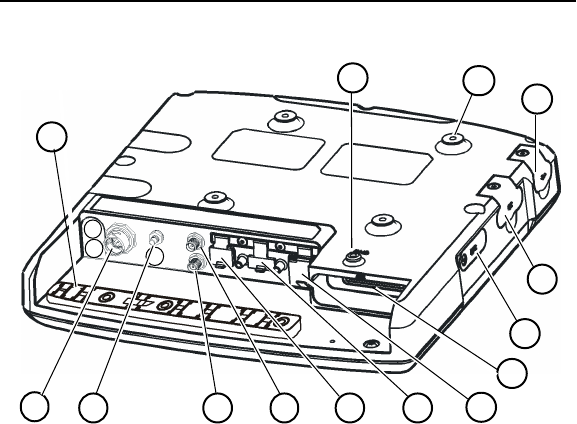
Quick Reference Guide 7
Back Features
1Only for VC6096.
2 Reverse thread - rotate counterclockwise to fasten connector.
3 1A power output (VC6090 only). Keep covered when not in use.
4 Includes: 8 digital inputs, 8 digital outputs, 2 analog inputs, 2 pins for de-
bugging, 2 full RS232, CAN2.0 - J1939 (Telemetry), J1708 (Telemetry). Note
that VC6090 does not support telemetry.
5 To avoid damage to the boss threads, use only the supplied screw.
1. PWR - Power connector
2. GPS antenna connector
3. WWAN antenna connector1
4. WLAN antenna connector1, 2
5. Client mini USB port, type B3
6. Host USB port, type A3
7. 10/100 Ethernet port3
8. Auxiliary port3, 4
9. SIM card slot3
10. SD memory card slot3
11. Host USB port, type A3
12. M4 screw mounting bosses
13. M4 Ground screw boss5
14. Cable Retention Bracket
6
8
7
1
12
13
43
10
9
11
52
14

8 VC6000 Series Vehicle Computers
Unpacking
The following items are contained inside the shipping box:
• VC6000 series
• Hardware Kit (including five M4 installation screws)
• This guide
Optional Accessories for VC6096
NOTE A hardware kit that contains optional accessories is
provided separately inside the shipping box.
Part Number Description
FLN4048 Combination Antenna
8508851K59 External GPS Antenna
PWRS-0102246H51R AC Power Supply Unit
23844-00-00R AC Cord (US), grounded, 3-wire
3087568V83 VC6096 WWAN RF Cable (3m, 9.8ft.)
3087568V84 VC6096 WLAN RF Cable (3m, 9.8ft.)
3071815Y13 VC6096 Vehicle Power Cable
3071815Y15 9-Pin Deutsch Cable
3071815Y14 6-Pin Deutsch Cable
3089906V60 50 Pin Cable
3089906V63 9-Pin Deutsch Telemetry Cable
3089906V61 6-Pin Deutsch Telemetry Cable
0771837Y26 Sapphire Mounting Adaptor

Quick Reference Guide 9
Optional Accessories for VC6090
Part Number Description
RAM-246U
RAM mount VESA100 C-size (1.5") ball, 4.75
SQ. Requires a RAM mount arm and base
(sold directly by RAM mount).
PWRS-14000-251R
DC-to-DC converter, 18 to 75VDC, including a
power cable with fuse. Use to power the
VC6090 on electric lift trucks with 24V, 36V
and 48V batteries.
30013095001 Power Cable, VC6090 to PWRS-14000-251R
DC-to-DC Converter
3071815Y13
10-33VDC power cable with fuse, includes
ignition sense. Use to power the VC6090 and
VC6096 from a gas/diesel-powered truck
using 12V or 24V battery.
PWRS-0102246H51R
100-240VAC power supply.
Use to power the VC6090 and VC6096 when it
is fix mounted or installed on AC-powered
carts.
23844-00-00R
US AC line cord, grounded, three wire for
power supplies PWRS-14000-148R and
PWRS-14000-241R as well as
PWRS-0102246H51R
3089906V60
RS232 and GPIO cable
Supports (2) RS-232 connection, (8) digital
inputs, (8) digital outputs, (20 analog inputs
and DB9 connector to support a Telematic
(VC6096 only) connectivity.
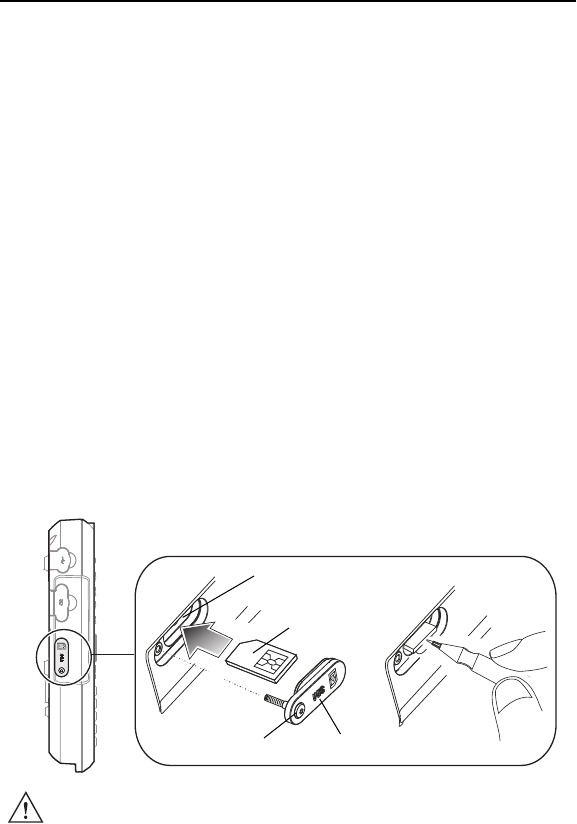
10 VC6000 Series Vehicle Computers
Installing a SIM Card (VC6096 only)
Before using the VC6096 in a cellular network, make sure that the
VC6096 is equipped with a Subscriber Identity Module (SIM) card,
obtained form your service provider. The SIM card is a small smart card
that fits into the VC6096. The SIM card holds the personalized
information about the VC6096, including network activation and phone
book entries.
To install the SIM card:
1. Remove the T8 screw that secures the SIM Card Door and open the
door.
2. Position the SIM Card with the contacts facing the back of the
VC6096, and insert into the SIM Slot. The SIM Card corner notch fits
into the slot only one way (See figure below).
3. Use a pen to push the SIM Card inwards to lock.
4. Place the SIM Card Door and secure the T8 Screw.
5. Torque the T8 Screw to 3.4 kgf-cm (3 in-lbs).
NOTE The VC6096 powers on only if the T8 Screw is fully secured.
CAUTION Ensure to torque the T8 screw to seal the VC6096 series
properly. Otherwise, sealing can be compromised.
SIM Card
SIM Slot
SIM Card Door
T8 Screw
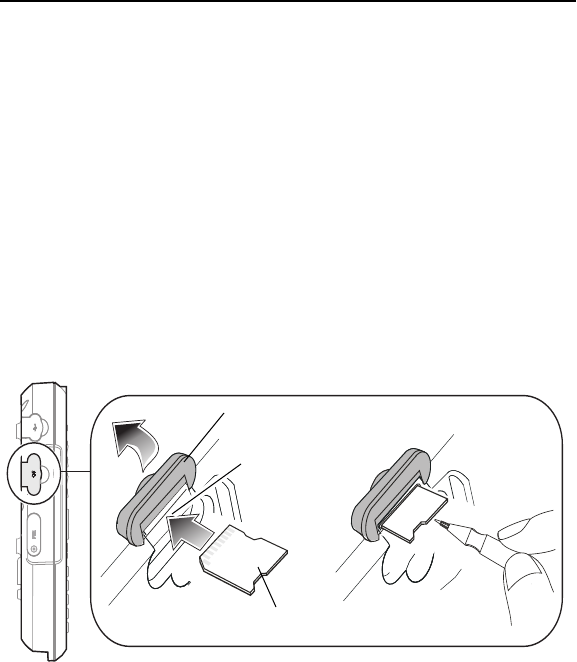
Quick Reference Guide 11
Installing the SD Memory Card
A Secure Digital (SD) memory card provides secondary non-volatile data
storage. Up to 32GB memory cards can be used. The card slot is located
on the side panel of the VC6000 series.
To install the SD memory card:
1. Lift up the Protective Rubber Cap that covers the Memory Card Slot.
2. Position the SD Memory Card with the contacts facing the back of
the VC6000 series and insert into the Memory Card Slot. The corner
notch of the SD Memory Card fits into the Memory Card Slot only
one way.
3. Use your pen to push the SD Memory Card inwards to lock.
4. Replace the Protective Rubber Cap to seal the Memory Card Slot.
SD Memory Card
Protective Rubber Cap
Memory Card Slot
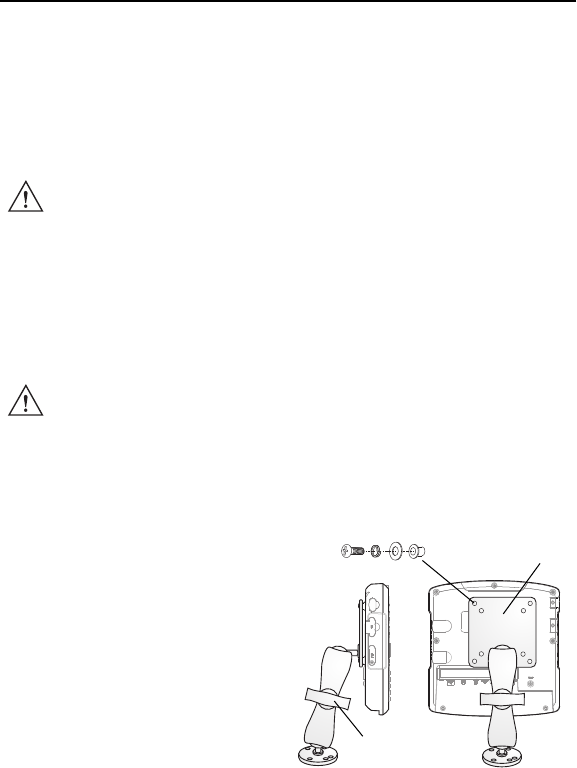
12 VC6000 Series Vehicle Computers
Mounting
The following mount examples should be used for installing the VC6000
series inside the vehicle. For optional mounting instructions, refer to the
documentation provided by the mount manufacturer. Recommended
mount manufacturer: RAM Mounts.
Free-standing Pedestal Mount
The mount allows the VC6000
series to be easily readjusted to
either the driver or passenger
sides in the most comfortable
location. A single adjustment knob
enables simultaneous adjustment
of both upper and lower ball joints.
The mount affixes to the VC6000
series using the M4 screws, spring
and flat washers and bushings
included inside the Hardware kit,
and to the vehicle’s dashboard
using self tapping screws or bolts,
provided by the mount
manufacturer.
WARNING!Vehicles equipped with air bags - An air bag inflates
with great force. DO NOT install the VC6000 series or
place objects, including other communication
equipment, in the area over the air bag or in the air bag
deployment area. If the communication equipment is
improperly installed and the air bag inflates, this could
cause serious injury.
CAUTION The VC6000 series are supplied with four M6 stainless
screws with flat and lock washers and a ground screw.
Do not use non-metric screws to avoid damaging the
screw threads resulting in housing damage.
R
Adjustment Knob
RAM-246U
(x4)
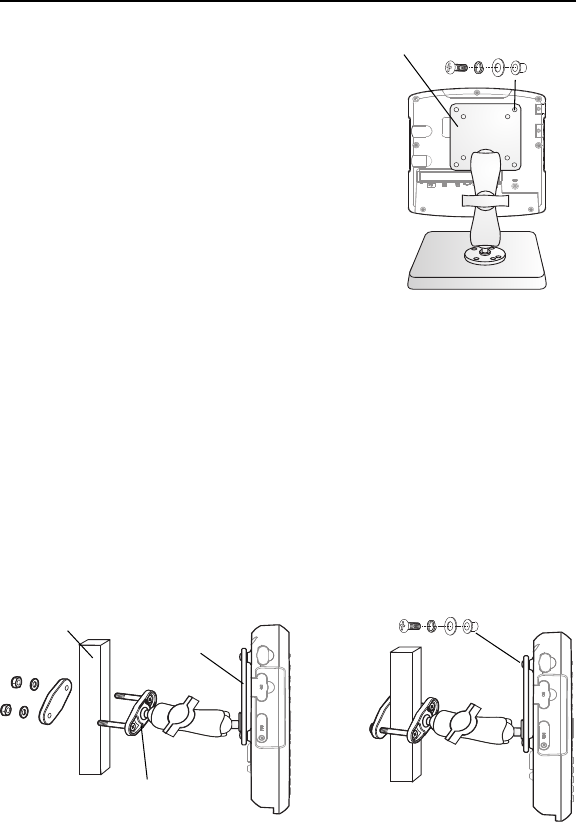
Quick Reference Guide 13
Desk Mount
The mount allows the VC6000 series to be
easily placed on a desk and adjusted to a most
comfortable screen view position. A single
adjustment knob enables adjustment of both
upper and lower ball joints simultaneously. The
mount affixes to the VC6000 series using the
M4 screws, spring and flat washers and
bushings included inside the Hardware Kit.
Lift Trucks
Use RAM Mount RAM-246U and RAM-247U-25 Rail Clamp Base or
alternative to install the VC6090 on the front arm of the electric lift truck.
Secure the VC6090 RAM-246U with four RAM-246U Screws supplied
with the VC6090.
Install a RAM Clamp Base to one of the roll cage uprights on the electric
lift truck by securing the bolts around one of the uprights using the
correct mounting hardware.
Horizontal Orientation — Square Upright Mounting Example
NOTE An alternative RAM base may be used may be used to install
the VC6090.
NOTE Avoid using horizontal mounting with arms longer than
RAM-201U to minimize amplification to lift truck vibration.
RAM-246U
(x4)
R
R
RAM-246U
(x4)
Upright
RAM-247U-25 Rail Clamp Base
(or alternative)
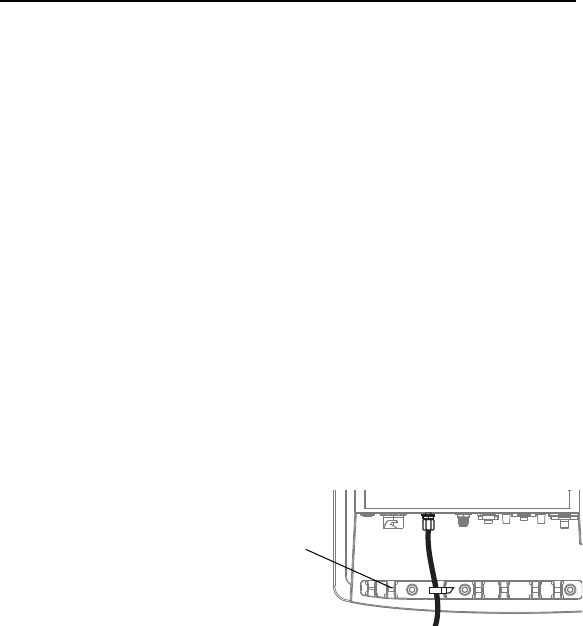
14 VC6000 Series Vehicle Computers
Guidelines for Routing Cables
• Establish a neat route for the cable, staying clear of moving parts or hot
surfaces.
• Fix the cable to an existing cable runs inside the vehicle using cable
ties.
• When the cabling must go through a panel, use a suitable cable guard.
• When fixing a conduit or a cable on the outside of a vehicle, use
P-Clips. Either drill and tap the hole or use a nut and bolt to secure the
clip.
• Ensure the cable does not have tight bends. The minimum recom-
mended radius is 6.35 cm (2.5 inches).
• Ensure cables do not swing or chafe on the structure. This often
requires using cable ties approximately every one foot, and ensuring
the cables do not flex often, especially where they connect to the
VC6000 series.
• If you must re-position the VC6000 series occasionally, ensure there is
enough slack in the cable to accommodate movement without putting
tension on the cable.
• Use plastic cable ties to
secure the cables to the
Cable Tie Bracket of the
VC6000.
• Connect the power as
close to the battery as
possible, but not directly
from the battery terminals, and not before any main fuse.
• On gasoline, diesel or propane electric lift trucks, connect the power as
close to the battery terminals as possible, and avoid using existing wir-
ing.
• Ensure that the fuse is as close as possible to the power source.
• The fuse must be securely mounted and in an accessible location.
• Do not install where the cable will be a trip hazard or interfere with
safety of day-to-day activities or otherwise create a hazardous condi-
tion.
Cable Tie
Bracket

Quick Reference Guide 15
• Fix the cable to existing cable runs inside the electric lift truck using
cable ties, but make sure they are away from any moving or hot sur-
faces.
• If the VC6090 needs to be re-positioned, be sure there is enough slack
in the cable to accommodate movement without putting tension on the
cable.
• DO NOT wind a cable in and out of the mesh on a cage.
• DO NOT route the cables on the outside of the electric lift truck or
areas where the electric lift truck may come in contact with objects.
Mounting the VC6000 Series on Gas/Diesel-Powered
Vehicles
Direct 10V to 33Vdc, with ignition sense for gas/diesel-powered lift trucks
and vehicles with 12V or 24V battery.
Connecting the Vehicle Power Cable
To connect the power cable:
1. Disconnect the power terminals from the vehicle battery.
2. Connect the black wire to the vehicle’s negative power source.
3. Connect the green wire to the vehicle’s ignition switch.
WARNING: Shortening or modifying the cable and/or by-passing
the in-line fuse voids the product warranty, nullifies the
product UL safety mark, and may result in a hazardous
condition. Do not modify the cable under any circum-
stance.
CAUTION DO NOT install the VC6000 series in a vehicle with a
positive ground electrical system.
WARNING: Failure to disconnect the battery before installing the
power converter may result in the injury or death of the
installer by electric shock.
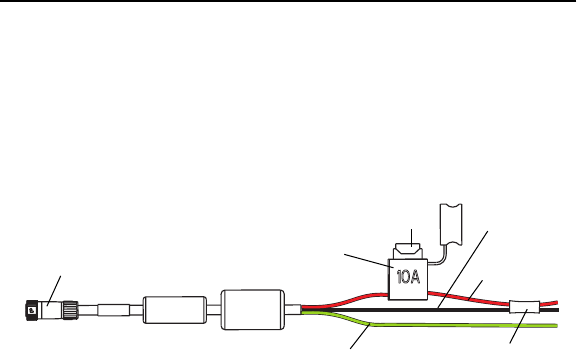
16 VC6000 Series Vehicle Computers
4. Connect the red wire to the vehicle’s positive power source. Place a
10 A SLO BLO fuse inside the fuse holder, connected in-line with the
Red Wire approximately 10 cm (4 inches) from the cable end.
5. Connect and turn clockwise to lock the Power Plug to Power Con-
nector (PWR) of the VC6000 series (See Back Features on page 7).
The length of the cable is 3 m (9.8 ft.).
6. When routing wires, slide Shrink Tubing over wires as required.
7. Connect the power terminals of the Vehicle Power Cable to the ter-
minals of the vehicle battery.
8. Reconnect the vehicle battery.
Red Wire
Black Wire
Green Wire
10 A Fuse SLO BLO
Power Plug
Shrink Tubing
Fuse Holder
Vehicle Power Cable

Quick Reference Guide 17
Mounting the VC6090 on Electric-Powered Lift Trucks
When installing the VC6090 on an electric-powered lift truck with 24V,
36V or 48V batteries, an external 18-75V DC-to-DC converter is
required.
Access Requirements
• Determine the best location for mounting the power converter, taking
into consideration the ease of accessing the power converter and
mounting requirements.
• Make sure that you have access to the power converter’s power-out
connection.
Important Mounting Information
• Mounting surface must be flat and rigid and it must extend evenly for
the entire length of the power converter surface.
• All four mounting holes must be used.
• Use the following mounting hardware to mount the Power Converter:
1.Four stainless steel cap screws, 1/4”-20-X (M6x1.0-X) where X
represents the length of the cap screws.
2.Four 1/4”-20 (M6x1.0) nyloc nuts
3.Four 1/4” (M6) flat washers
• When installing the power converter, care must be taken to ensure that
the mounting surface is fully supported. Additional plates may be
required to achieve this.
NOTE Do not directly connect the VC6090 to the electric lift truck
battery without the DC-to-DC converter.
CAUTION If mounting to a thin surface, a reinforcing plate is
required.
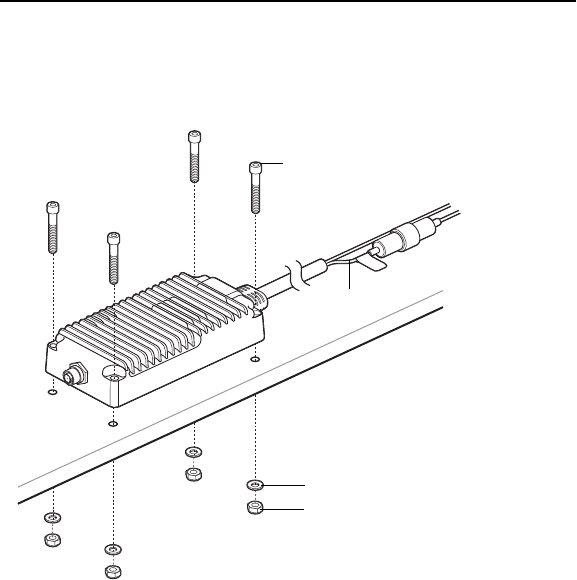
18 VC6000 Series Vehicle Computers
• Check that any attached cables are routed so that they do not interfere
with the operation of forks or other moving parts
To connect the Electric Lift Truck Power Converter to power:
1. Disconnect the fork lift battery.
NOTE See the electric lift truck Owner's Manual for specific wiring
information.
Cap Screws (4x)
Flat Washers (4x)
nyloc nuts (4x)
Electric Lift Truck Power Converter
DC Cable
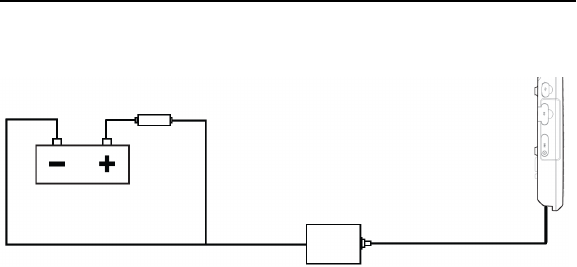
Quick Reference Guide 19
2. Connect the Power Converter to the vehicle battery as shown
below:
3. Confirm the fuse is in the fuse mount:
• For a 12V or 24V fork lift, use a 8A fast blow ceramic fuse.
• For a 36V, 48V, or 60V fork lift, use a 5A fast blow ceramic fuse.
4. Route the cable from the power converter to the power source using
the Cabling Installation Guidelines (see Guidelines for Routing
Cables on page 14).
5. Connect the red wire to the electric lift truck's positive power source.
Connect the black wire to the electric lift truck's negative power
source.
6. Ensure the wiring connections created are sufficiently insulated from
each other.
7. Reconnect the electric lift truck battery.
Fuse mount and fuse
Power Converter
6 ft. (1.83 m) 6 ft. (1.83 m)
Red
Black
Vehicle Battery
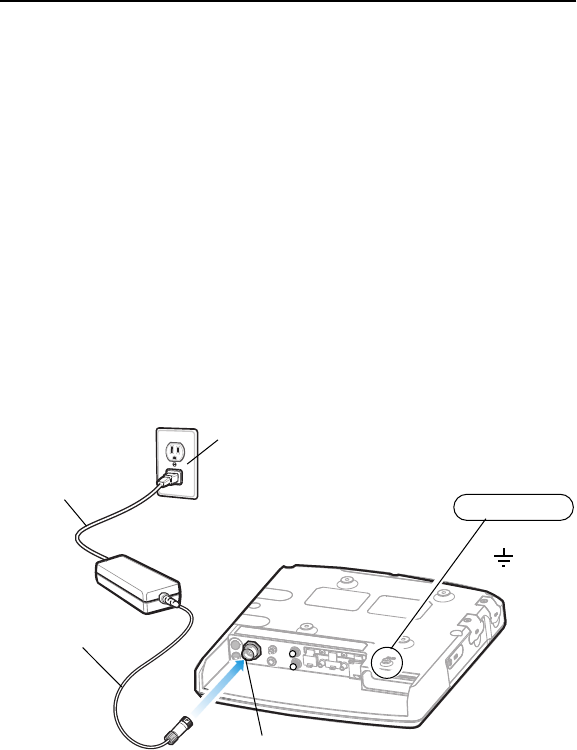
20 VC6000 Series Vehicle Computers
Mounting the VC6000 Series on AC-powered Carts and
Stationary Installation
AC-powered carts and stationary installation are powered using an a 100
to 240VAC Indoor Power Supply Unit.
To connect power to the VC6000 series:
1. Connect a ground wire between the VC6000 series and the facility
ground system. The ground wire ring lugs should be connected to
the Ground Point (GND) on the back of the VC6000 series using M4
screw.
2. Attach the 12 V DC cable of the Indoor Power Supply Unit to the
Power Connector at the back of the VC6000 series and turn clock-
wise to lock. Rotate clockwise to lock the connector.
3. Connect the AC Cord into the Indoor Power Supply Unit.
NOTE Grounding the unit is optional. To ground the unit, use a
18AWG ground wire between the VC6000 series Ground
Point (GND) and the facility ground system. To avoid damage
to the boss threads, use only the supplied M4 screw.
12 V DC Cable
AC Cord
Ground Point
GND
Indoor Power Supply Unit
(For indoor use only in dry locations)
Power Connector
100-240 V AC / 50-60 Hz Power Outlet

Quick Reference Guide 21
4. Connect the plug of the AC Cord into a 100-240 V AC / 50-60 Hz
Power Outlet.
5. If installed on an AC-powered Cart, secure the Indoor Power Supply
Unit to the AC-powered Cart.
Ground Polarity
Connecting the Telemetry Cable (VC6096 only)
The following example shows the 6 Pin Deutsch Telemetry Cable (p/n
3071815Y146). For detailed description of all telemetry cables, refer to
VC6000 series Product Reference Guide, p/n 6802986C08-x.
Telemetry Cable
1. Plug the J1 connector into the Auxiliary port of the VC6000 series
(See Back Features on page 7) and fasten the connection screws of
the connector.
2. Plug connectors J2 and J3 to the telemetry receptacles of your vehi-
cle data bus.
NOTE The total length of the power supply cables is 4.3 m (14.1 ft.).
CAUTION The VC6000 series should operate only in negative
ground electrical systems. Check the ground polarity of
the vehicle before starting the VC6000 series installation
to verify that the polarity is correct. Accidentally reversing
the polarity will not damage the VC6000 series, but will
cause the cable fuse to blow.
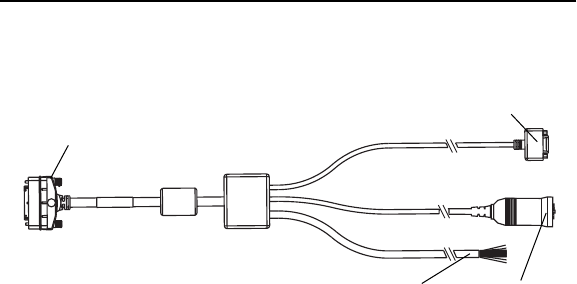
22 VC6000 Series Vehicle Computers
3. Connect the I/O Wires as required.
NOTE For Input/Output (I/O) Wires connections, refer to the VC6000
Series Product Reference Guide.
J1 - To VC6000 series Auxiliary port
J2 - RS232 Connector
J3 - Deutsch 6 pin
Telemetry
Connector
Telemetry Cable
I/O Wires: 8 digital inputs, 8 digital outputs, 2 analog inputs, Debug
(2 wires for debugging). See label on wires. Maximum current
through wires 0.5 A
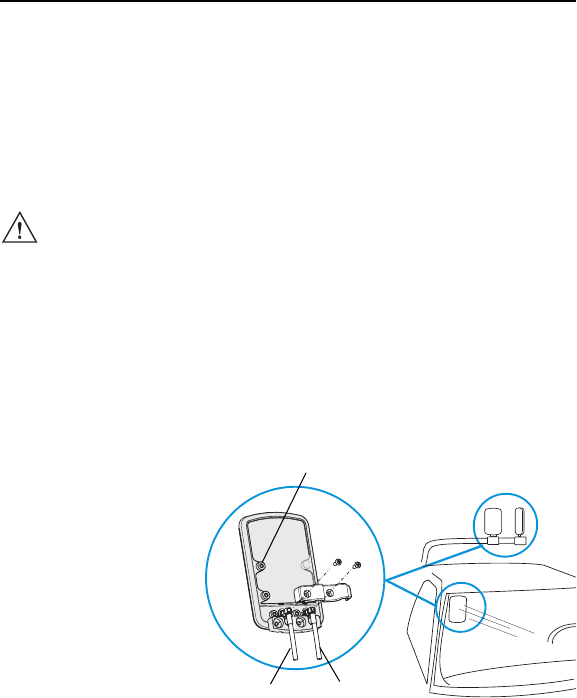
Quick Reference Guide 23
Mounting the Combination Antenna (VC6096 only)
The Combination Antenna is an optional omni-directional WWAN and
WLAN antenna used with the VC6096. The antenna mounts
inside/outside the vehicle cabin or indoors/outdoors.
The antenna has two external RF connectors that connect to the
VC6096 via two low loss RF coax cables.
Installation guidelines:
1. For best performance, it is recommended to install the antenna out-
side of the cabin. When installing the antenna in the vehicle cabin or
indoors, keep a minimum distance of 70 cm (2.3 ft.) between the
antenna and the VC6096.
2. The antenna
should be directed
vertically to the
horizon to assure
maximum expo-
sure.
3. To ensure best
performance, the
antenna should
be mounted as far
away as possible
from walls, floors
and metal contain-
ing objects. Keep an obstacle free zone of 10 cm (3.9 inches) from
walls, cabinets, air duct, metal-framed windows, doors etc.
CAUTION To avoid damage to the VC6096, make sure to
disconnect the power cable from the VC6096 before
connecting the antenna cable. When installing the
antenna cable, make sure to connect the antenna side of
the cable before connecting to the VC6096.
WWAN
Cable
WLAN
Cable
M4 screw mounting bosses used for mounting bracket
Vehicle
Windshield
or
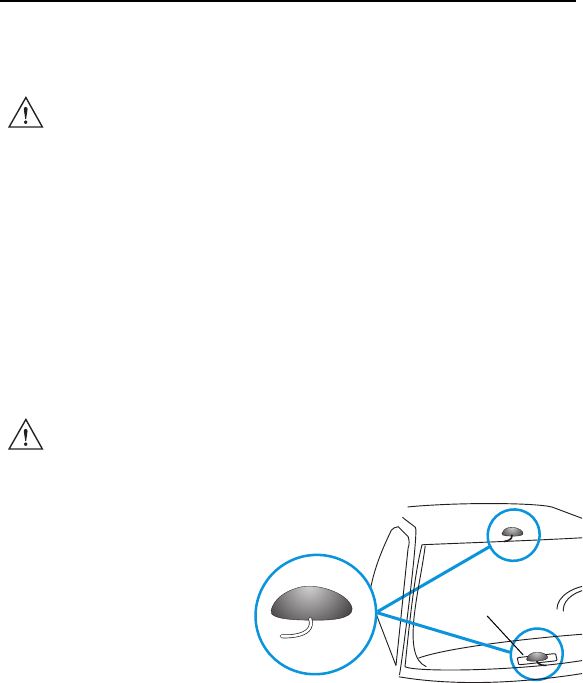
24 VC6000 Series Vehicle Computers
4. When mounting the antenna inside the vehicle, it is recommended
to install the antenna at the top right hand side of the windshield.
Mounting the GPS Antenna (VC6096 only)
The VC6096 is supplied with an internal module of Global Positioning
System (GPS).
Connect the cable connector of the GPS antenna to the GPS connector
at the back of the VC6096.
Installation guidelines:
1. Recommended GPS
antenna - Motorola part
number 8508851K59.
2. The GPS antenna must
be mounted on the top
of the dashboard or
vehicle roof. For best
performance, install the
GPS antenna on the center-line of the vehicle roof.
3. Keep a minimum distance of 40 cm (16 inches) between the Combi-
nation antenna and the GPS antenna.
4. The antenna is attached by a magnet to a flat metal surface (mini-
mum 7 cm x 7 cm, 2.75 inches x 2.75 inches). Before mounting the
GPS antenna on a dashboard, install a flat Metal Plate on the dash-
board to hold the GPS antenna.
WARNING!1. Keep a minimum lateral distance of 20 cm (8 inches)
between the driver/passenger and the antenna. Contact
your professional installer, VAR, or antenna
manufacturer for proper installation requirements.
2. To ensure safe driving, when mounting the
Combination Antenna next to the windshield, do not
block the driver’s field of view.
CAUTION To avoid damage to the VC6096, make sure to
disconnect the power cable from the VC6096 before
connecting the antenna cable.
GPS Antenna
Metal Plate

Quick Reference Guide 25
5. The antenna should be directed parallel to the horizon to assure
exposure to as many satellites as possible.
6. If possible, the antenna location must not be obstructed by any
structure or object. When mounting the antenna on a roof ensure at
least 7.6 cm (3 inches) of clear space around it.
Operating the VC6000 series
System Indication LED
The System Indication LED is located inside the Power Button (See
Front Features on page 6).
The System Indication LED indicates the following states:
Controlling Screen Brightness
There are five levels of screen brightness (including turning off).
To adjust the brightness of the screen, press the Brightness down button
to decrease the brightness or the Brightness up button to increase the
brightness. The VC6000 series automatically returns to normal operation
after six seconds if the Brightness up/down key is not pressed.
LED State Indication
Off Normal operation
Fast flashing amber • Critical power event. Input power is out of
operating range. The VC6000 series may turn
off - save your entries.
• Vehicle engine start - no action is required.
• Cold reset is active - no action is required.
Slowly flashing amber Critical temperature event. Ambient temperature
is out of operating range -20 °C to 60 °C (-4 °F to
140 °F). The VC6000 series may turn off.
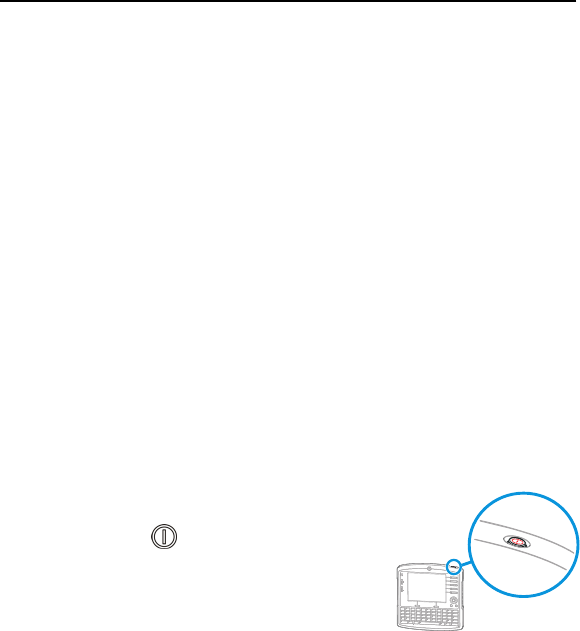
26 VC6000 Series Vehicle Computers
Controlling Keypad Illumination
There are five levels of Keypad Illumination. To adjust the Keypad
Illumination:
1. Press the Ctrl key to lock in down position.
2. Press the Brightness up/down key to increase/decrease the keypad
illumination. The VC6000 series automatically returns to normal
operation after six seconds if the up/down key is not pressed.
3. Press the Ctrl key to unlock in up position.
Standby Mode
Standby mode is a power saving mode enabled only when the vehicle
ignition key is switched to the OFF position.
In Standby mode, the screen display and backlight illumination
automatically turn off after a period of two minutes when VC6000 series
is not active.
Resume from Standby Mode
To resume from Standby mode, press any
key, or touch the screen, or momentarily press
the Power Button .
The VC6000 series can be set to
automatically resume from Standby mode
when: turning On the ignition key, connecting
or removing a USB device, pressing a
keyboard key, receiving an alarm, pressing the touch screen,
communicating over Bluetooth, communicating over WWAN.
Resetting the VC6000 series
If the VC6000 series stops responding to inputs, perform the reset
actions in the following order:
Power Button

Quick Reference Guide 27
Warm Boot
Warm boot may become necessary when an application running on your
VC6000 series does not respond after performing initial reset.
To perform warm boot:
Press and hold the Power Button for five seconds and release.
Cold Boot
Cold boot may become necessary when your VC6000 series is jammed
and does not respond after performing warm boot.
Cold boot restarts the VC6000 series by performing an ungraceful
shutdown of all running applications and powering off the VC6000 series.
Cold boot resets information stored in all running applications.
Data saved on flash memory or a memory card is not lost.
To perform a cold boot:
Press and hold + + Power Button .
You can also perform cold boot by holding the Power Button pressed
for 25 seconds.
Function Keys
The five function keys on the front right hand side of the panel (See Front
Features on page 6) can be set to perform dedicated functions, such
switching between different software application screens. To know more
about the function of each key, refer to your enterprise application guide.
CAUTION Warm boot may cause lost of information from programs
currently running on the computer.

28 VC6000 Series Vehicle Computers
Troubleshooting
Regulatory Information
All Motorola devices are designed to be compliant with rules and
regulations in locations they are sold and will be labeled as required.
This device is approved under Enterprise Mobility business of Motorola,
Inc., (“Motorola”).
Problem Cause Solution
The VC6000
series does not
power on.
Vehicle ignition key in
OFF position.
Switch on the vehicle
ignition key to the ON
position.
SIM door is open. Close the SIM door
properly and secure screw.
Drained vehicle battery. Charge or replace battery.
Power cable is
disconnected.
Connect the Power cable.
Low Battery
level warning is
issued.
Vehicle battery voltage
dropped below 9 V DC.
Start the vehicle engine to
charge the battery.
Replace battery.
LCD and
Keypad
backlight do
not function.
Critical Battery level.
Vehicle battery Voltage
dropped below 8V.
Start the vehicle engine to
charge the battery.
Replace battery.
Display
backlight
intensity is
reduced.
Display temperature is
below 10 °C or above
35 °C (below 50 °F or
above 95 °F).
Control the temperature
inside the vehicle.
The VC6000
series powers
off during
operation.
VC6000 series
temperature is out of
range:
-20 °C to 60 °C
(-4 °F to 140 °F).
Control the temperature
inside the vehicle.
To resume operation,
momentarily press the
Power Button.

Quick Reference Guide 29
Regulatory Information is available in English, French, German, Italian,
Spanish, Turkish, Simplified Chinese.
Local language translations are available at the following web site:
www.motorola.com/enterprisemobility/manuals.
This device is approved under the Motorola, Inc (“Motorola”). Any
changes or modifications to Motorola equipment, not expressly approved
by Motorola, could void the user's authority to operate the equipment.
Antennas: Use only the supplied or an approved replacement antenna.
Unauthorized antennas, modifications, or attachments could cause
damage and may violate regulations.
Country Approvals
Regulatory markings are applied to the device signifying the radio(s) are
approved for use in the following countries: United States, Canada and
Europe 1, 2.
Please refer to the Motorola Declaration of Conformity (DoC) for details
of other country markings. This is available at:
www.motorola.com/enterprisemobility/doc.
NOTE 1: For 2.4GHz Products: Europe includes, Austria, Belgium,
Czech Republic, Cyprus, Denmark, Estonia, Finland, France,
Germany, Greece, Hungary, Iceland, Ireland, Italy, Latvia,
Liechtenstein, Lithuania, Luxembourg, Malta, Netherlands,
Norway, Poland, Portugal, Slovak Republic, Slovenia, Spain,
Sweden, Switzerland and the United Kingdom.
NOTE 2: The use of 5GHz RLAN's has varying restrictions of use;
please refer to the Motorola Declaration of Conformity (DoC)
for details.
CAUTION Only use Motorola approved and UL Listed accessories.
Do NOT attempt to charge damp/wet mobile computers.
All components must be dry before connecting to power
source.
CAUTION Operation of the device without regulatory approval is
illegal.

30 VC6000 Series Vehicle Computers
Health and Safety Recommendations
Ergonomic Recommendations
• Reduce or eliminate repetitive motion
• Maintain a natural position
• Reduce or eliminate excessive force
• Keep objects that are used frequently within easy reach
• Perform tasks at correct heights
• Reduce or eliminate vibration
• Reduce or eliminate direct pressure
• Provide adjustable workstations
• Provide adequate clearance
• Provide a suitable working environment
Vehicle Installation
RF signals may affect improperly installed or inadequately shielded
electronic systems in motor vehicles (including safety systems).
Check with the manufacturer or its representative regarding your vehicle.
You should also consult the manufacturer of any equipment that has
been added to your vehicle.
An air bag inflates with great force. DO NOT place objects, including
either installed or portable wireless equipment, in the area over the air
bag or in the air bag deployment area. If in-vehicle wireless equipment is
improperly installed and the air bag inflates, serious injury could result.
Position your device within easy reach. Be able to access your device
without removing your eyes from the road.
Note: Connection to an alert device that will cause a vehicle horn to
sound or lights to flash, on receipt of a call on public roads, is not
permitted.
CAUTION In order to avoid or minimize the potential risk of
ergonomic injury follow the recommendations below.
Consult with your local Health & Safety Manager to ensure
that you are adhering to your company's safety programs
to prevent employee injury.

Quick Reference Guide 31
Safety on the Road
Do not take notes or use the device while driving. Jotting down a “to do”
list or flipping through your address book takes attention away from your
primary responsibility, driving safely.
When driving a car, driving is your first responsibility - Give full attention
to driving. Check the laws and regulations on the use of wireless devices
in the areas where you drive. Always obey them.
When using a wireless device behind the wheel of a car, practice good
common sense and remember the following tips:
1. Get to know your wireless device and any features such as speed
dial and redial. If available, these features help you to place your call
without taking your attention off the road.
2. When available, use a hands free device.
3. Let the person you are speaking with know you are driving; if neces-
sary, suspend the call in heavy traffic or hazardous weather condi-
tions. Rain, sleet, snow, ice, and even heavy traffic can be
hazardous.
4. Dial sensibly and assess the traffic; if possible, place calls when you
are not moving or before pulling into traffic. Try to plan calls when
your car will be stationary. If you need to make a call while moving,
dial only a few numbers, check the road and your mirrors, then con-
tinue.
5. Do not engage in stressful or emotional conversations that may be
distracting. Make people you are talking with aware you are driving
and suspend conversations that have the potential to divert your
attention from the road.
6. Use your wireless phone to call for help. Dial the Emergency ser-
vices, (9-1-1 in the US, and 1-1-2 in Europe) or other local emer-
gency number in the case of fire, traffic accident or medical
emergencies. Remember, it is a free call on your wireless phone!.
The call can be made regardless of any security codes and depend-
ing on a network, with or without a SIM card inserted.
7. Use your wireless phone to help others in emergencies. If you see
an auto accident, crime in progress or other serious emergency
where lives are in danger, call the Emergency Services, (9-1-1 in the

32 VC6000 Series Vehicle Computers
US, and 1-1-2 in Europe) or other local emergency number, as you
would want others to do for you.
8. Call roadside assistance or a special non-emergency wireless assis-
tance number when necessary. If you see a broken-down vehicle
posing no serious hazard, a broken traffic signal, a minor traffic acci-
dent where no one appears injured, or a vehicle you know to be sto-
len, call roadside assistance or other special non emergency
wireless number. “The wireless industry reminds you to use your
device / phone safely when driving.”
Warnings for Use of Wireless Devices
Please observe all warning notices with regard to the usage of wireless
devices.
Potentially Hazardous Atmospheres
You are reminded of the need to observe restrictions on the use of radio
devices in fuel depots, chemical plants etc. and areas where the air
contains chemicals or particles (such as grain, dust, or metal powders)
and any other area where you would normally be advised to turn off your
vehicle engine.
Hearing Aids
The wireless device may interfere with some hearing aids. In the event of
interference you may want to consult your hearing aid supplier to discuss
solutions.
Other Medical Devices
Please consult your physician or the manufacturer of the medical device,
to determine if the operation of your wireless product may interfere with
the medical device.
Safety Information
The device complies with Internationally recognized standards covering
Maximum Permissible Exposure (MPE) related to human exposure to
electromagnetic fields from radio devices.
Reducing RF Exposure - Use Properly
It is advisable to use the device only in the normal operating position.
FCC / EU RF Exposure Guidelines

Quick Reference Guide 33
Remote and Standalone Antenna Configurations
To comply with FCC RF exposure requirements, antennas that are
mounted externally at remote locations or operating near users at
stand-alone desk of similar configurations must operate with a minimum
separation distance of 20 cm (8 inches) from all persons.
To satisfy FCC RF exposure requirements, a mobile transmitting device
must operate with a minimum separation distance of 20 cm (8 inches) or
more from a person's body.
Indoor Power Supply
Use only a Motorola approved power supply P.N 0102246H51,
Input:100-240 V AC / 50-60 Hz, output rated: 12 V DC, 5 A maximum.
The power supply is certified to EN60950-1 with SELV outputs. Use of
alternative power supply will invalidate any approval given to this device
and may be dangerous.
Wireless Devices - Countries
Country Roaming
This device incorporates the International Roaming feature
(IEEE802.11d) which will ensure the product operates on the correct
channels for the particular country of use.
Ad-Hoc Operation
Ad-Hoc operation is limited to Channels 36-48 (5150-5250 MHz). Use of
this band is restricted to Indoor Use Only, any other use will make the
operation of this device illegal.
Radio Frequency Interference Requirements
Note: This equipment has been tested and found to comply with the
limits for a Class B digital device, pursuant to Part 15 of the FCC rules.
These limits are designed to provide reasonable protection against
harmful interference in a residential installation. This equipment
generates, uses, and can radiate radio frequency energy and, if not
installed and used in accordance with the instructions, may cause
harmful interference to radio communications. However there is no
guarantee that interference will not occur in a particular installation. If this
equipment does cause harmful interference to radio or television
reception, which can be determined by turning the equipment off and on,

34 VC6000 Series Vehicle Computers
the user is encouraged to try to correct the interference by one or more
of the following measures:
• Reorient or relocate the receiving antenna
• Increase the separation between the equipment and receiver
• Connect the equipment into an outlet on a circuit different from that to
which the receiver is connected
• Consult the dealer or an experienced radio/TV technician for help
Radio Transmitters (Part 15)
This device complies with Part 15 of the FCC Rules. Operation is subject
to the following two conditions: (1) this device may not cause harmful
interference, and (2) this device must accept any interference received,
including interference that may cause undesired operation.
Radio Frequency Interference Requirements - Canada
This Class B digital apparatus complies with Canadian ICES-003. Cet
appareil numérique de la classe B est conforme à la norme NMB-003 du
Canada.
IMPORTANT: In the band 5150- 5250 MHz, the device may only be used
indoors to reduce potential for harmful interference to co- channel mobile
satellite systems.
Radio Transmitters
This device complies with RSS 210 of Industry & Science Canada.
Operation is subject to the following two conditions: (1) this device may
not cause harmful interference and (2) this device must accept any
interference received, including interference that may cause undesired
operation.
Label Marking: The Term “IC:” before the radio certification only signifies
that Industry Canada technical specifications were met.
Marking and European Economic Area (EEA)
The use of 2.4 GHz RLAN's, have the following restrictions:
•Maximum radiated transmit power of 100 mW EIRP in the fre-
quency range 2.400 -2.4835 GHz
• France, equipment is restricted to 2.4 - 2.454 GHz
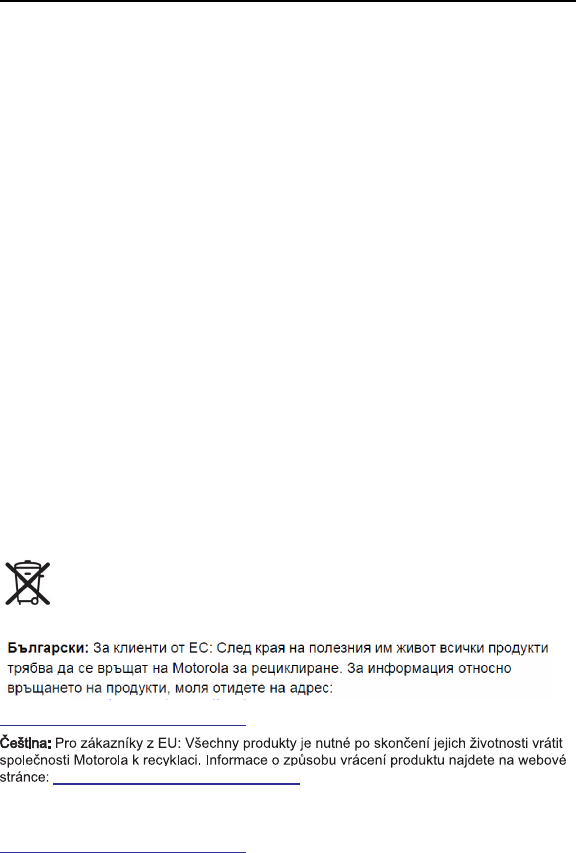
Quick Reference Guide 35
• Italy requires a user license for outside usage
The use of 5GHz RLAN's has varying restrictions for use within the EEA;
please refer to the Motorola Declaration of Conformity (DoC) for details
at: www.motorola.com/enterprisemobility/doc
Bluetooth® Wireless Technology for use through the EEA has the
following restrictions:
• Maximum radiated transmit power of 100mW EIRP in the frequency
range 2.400 -2.4835 GHz
• France, outside usage is restricted to 10mW EIRP
• Italy requires a user license for outside usage.
Statement of Compliance
Motorola, Inc., hereby, declares that this device is in compliance with the
essential requirements and other relevant provisions of Directives
1999/5/EC. Declaration of Conformities may be obtained from:
www.motorola.com/enterprisemobility/doc
Other Countries
2.4GHz Radio Devices:
• Mexico - Restrict Frequency Range to: 2.450 - 2.4835 GHz.
• Sri Lanka - Restrict Frequency Range to: 2.400 - 2.430 GHz.
Waste Electrical and Electronic Equipment (WEEE)
English: For EU Customers: All products at the end of their life must be
returned to Motorola for recycling. For information on how to return
product, please go to: www.motorola.com/recycling/weee.
www.motorola.com/recycling/weee.
Dansk: Til kunder i EU: Alle produkter skal returneres til Motorola til recirkulering,
når de er udtjent. Læs oplysningerne om returnering af produkter på:
www.motorola.com/recycling/weee.
www.motorola.com/recycling/weee
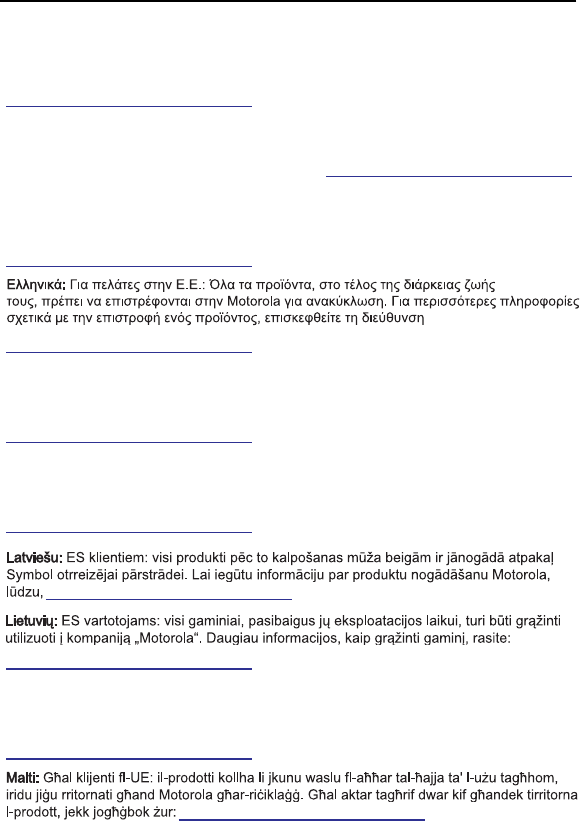
36 VC6000 Series Vehicle Computers
Deutsch: Für Kunden innerhalb der EU: Alle Produkte müssen am Ende ihrer
Lebensdauer zum Recycling an Motorola zurückgesandt werden. Informationen
zur Rücksendung von Produkten finden Sie unter
www.motorola.com/recycling/weee.
Eesti: EL klientidele: kõik tooted tuleb nende eluea lõppedes tagastada
taaskasutamise eesmärgil Motorola'ile. Lisainformatsiooni saamiseks toote
tagastamise kohta külastage palun aadressi: www.motorola.com/recycling/weee.
Español: Para clientes en la Unión Europea: todos los productos deberán
entregarse a Motorola al final de su ciclo de vida para que sean reciclados. Si
desea más información sobre cómo devolver un producto, visite:
www.motorola.com/recycling/weee.
www.motorola.com/recycling/weee.
Français: Clients de l'Union Européenne: Tous les produits en fin de cycle de vie
doivent être retournés à Motorola pour recyclage. Pour de plus amples
informations sur le retour de produits, consultez:
www.motorola.com/recycling/weee.
Italiano: per i clienti dell'UE: tutti i prodotti che sono giunti al termine del rispettivo
ciclo di vita devono essere restituiti a Motorola al fine di consentirne il riciclaggio.
Per informazioni sulle modalità di restituzione, visitare il seguente sito Web:
www.motorola.com/recycling/weee.
www.motorola.com/recycling/weee.
Magyar: Az EU-ban vásárlóknak: Minden tönkrement terméket a Motorola
vállalathoz kell eljuttatni újrahasznosítás céljából. A termék visszajuttatásának
módjával kapcsolatos tudnivalókért látogasson el a
www.motorola.com/recycling/weee weboldalra..
Nederlands: Voor klanten in de EU: alle producten dienen aan het einde van hun
levensduur naar Motorola te worden teruggezonden voor recycling. Raadpleeg
www.motorola.com/recycling/weee
www.motorola.com/recycling/weee

www.motorola.com/recycling/weee voor meer informatie over het terugzenden
van producten.
Português: Para clientes da UE: todos os produtos no fim de vida devem ser
devolvidos à Motorola para reciclagem. Para obter informações sobre como
devolver o produto, visite: www.motorola.com/recycling/weee.
Românesc: Pentru clienþii din UE: Toate produsele, la sfârºitul duratei lor de
funcþionare, trebuie returnate la Motorola pentru reciclare. Pentru informaþii
despre returnarea produsului, accesaþi: www.motorola.com/recycling/weee.
Slovenski: Za kupce v EU: vsi izdelki se morajo po poteku življenjske dobe vrniti
podjetju Motorola za reciklažo. Za informacije o vraèilu izdelka obišèite:
www.motorola.com/recycling/weee.
Suomi: Asiakkaat Euroopan unionin alueella: Kaikki tuotteet on palautettava
kierrätettäväksi Motorola-yhtiöön, kun tuotetta ei enää käytetä. Lisätietoja tuotteen
palauttamisesta on osoitteessa www.motorola.com/recycling/weee.
Svenska: För kunder inom EU: Alla produkter som uppnått sin livslängd måste
returneras till Motorola för återvinning. Information om hur du returnerar produkten
finns på www.motorola.com/recycling/weee.
www.motorola.com/recycling/weee
www.motorola.com/recycling/weee

If you have a problem using the equipment, contact your facility’s Technical or
Systems Support. If there is a problem with the equipment, they will contact the
Motorola Enterprise Mobility Support at:
www.motorola.com/enterprisemobility/support.
For the latest version of this guide go to:
www.motorola.com/enterprisemobility/manuals.
Motorola Solutions, Inc.
One Motorola Plaza
Holtsville, New York 11742, USA
1-800-927-9626
http://www.motorolasolutions.com
MOTOROLA, MOTO, MOTOROLA SOLUTIONS and the Stylized M Logo are trademarks or
registered trademarks of Motorola Trademark Holdings, LLC and are used under license. All other
trademarks are the property of their respective owners.
© 2012 Motorola Solutions, Inc. All Rights Reserved.
6802986C09 Revision D - March 2012
@6802986C09@
Service Information